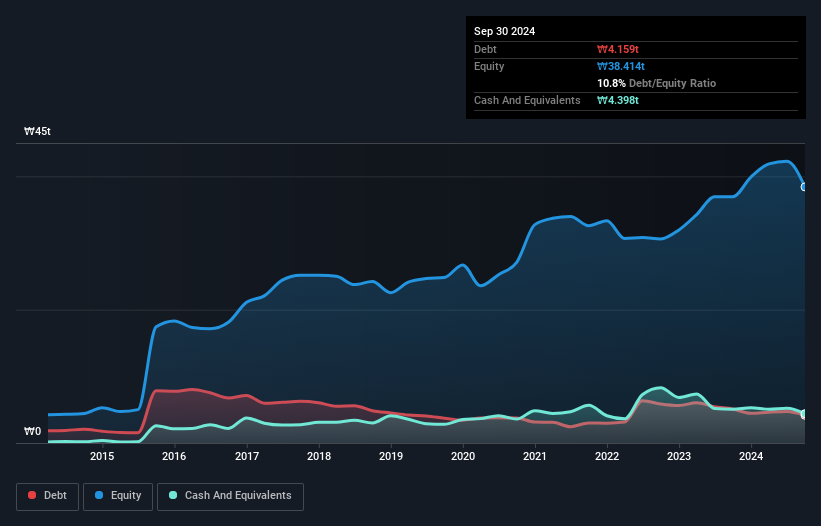
Legendary fund manager Li Lu (who Charlie Munger backed) once said, 'The biggest investment risk is not the volatility of prices, but whether you will suffer a permanent loss of capital.' It's only natural to consider a company's balance sheet when you examine how risky it is, since debt is often involved when a business collapses. We note that Samsung C&T Corporation (KRX:028260) does have debt on its balance sheet. But the real question is whether this debt is making the company risky.
Why Does Debt Bring Risk?
Debt assists a business until the business has trouble paying it off, either with new capital or with free cash flow. If things get really bad, the lenders can take control of the business. However, a more usual (but still expensive) situation is where a company must dilute shareholders at a cheap share price simply to get debt under control. Of course, the upside of debt is that it often represents cheap capital, especially when it replaces dilution in a company with the ability to reinvest at high rates of return. The first thing to do when considering how much debt a business uses is to look at its cash and debt together.
Check out our latest analysis for Samsung C&T
What Is Samsung C&T's Debt?
The image below, which you can click on for greater detail, shows that Samsung C&T had debt of ₩4.16t at the end of September 2024, a reduction from ₩5.10t over a year. But on the other hand it also has ₩4.40t in cash, leading to a ₩239.3b net cash position.

How Strong Is Samsung C&T's Balance Sheet?
Zooming in on the latest balance sheet data, we can see that Samsung C&T had liabilities of ₩14t due within 12 months and liabilities of ₩9.74t due beyond that. Offsetting this, it had ₩4.40t in cash and ₩7.74t in receivables that were due within 12 months. So its liabilities outweigh the sum of its cash and (near-term) receivables by ₩12t.
Samsung C&T has a very large market capitalization of ₩20t, so it could very likely raise cash to ameliorate its balance sheet, if the need arose. But it's clear that we should definitely closely examine whether it can manage its debt without dilution. Despite its noteworthy liabilities, Samsung C&T boasts net cash, so it's fair to say it does not have a heavy debt load!
Fortunately, Samsung C&T grew its EBIT by 3.9% in the last year, making that debt load look even more manageable. When analysing debt levels, the balance sheet is the obvious place to start. But it is future earnings, more than anything, that will determine Samsung C&T's ability to maintain a healthy balance sheet going forward. So if you're focused on the future you can check out this free report showing analyst profit forecasts.
Finally, a business needs free cash flow to pay off debt; accounting profits just don't cut it. Samsung C&T may have net cash on the balance sheet, but it is still interesting to look at how well the business converts its earnings before interest and tax (EBIT) to free cash flow, because that will influence both its need for, and its capacity to manage debt. In the last three years, Samsung C&T's free cash flow amounted to 43% of its EBIT, less than we'd expect. That weak cash conversion makes it more difficult to handle indebtedness.
Summing Up
Although Samsung C&T's balance sheet isn't particularly strong, due to the total liabilities, it is clearly positive to see that it has net cash of ₩239.3b. And it also grew its EBIT by 3.9% over the last year. So we don't have any problem with Samsung C&T's use of debt. The balance sheet is clearly the area to focus on when you are analysing debt. However, not all investment risk resides within the balance sheet - far from it. Be aware that Samsung C&T is showing 1 warning sign in our investment analysis , you should know about...
At the end of the day, it's often better to focus on companies that are free from net debt. You can access our special list of such companies (all with a track record of profit growth). It's free.
New: Manage All Your Stock Portfolios in One Place
We've created the ultimate portfolio companion for stock investors, and it's free.
• Connect an unlimited number of Portfolios and see your total in one currency
• Be alerted to new Warning Signs or Risks via email or mobile
• Track the Fair Value of your stocks
Have feedback on this article? Concerned about the content? Get in touch with us directly. Alternatively, email editorial-team (at) simplywallst.com.
This article by Simply Wall St is general in nature. We provide commentary based on historical data and analyst forecasts only using an unbiased methodology and our articles are not intended to be financial advice. It does not constitute a recommendation to buy or sell any stock, and does not take account of your objectives, or your financial situation. We aim to bring you long-term focused analysis driven by fundamental data. Note that our analysis may not factor in the latest price-sensitive company announcements or qualitative material. Simply Wall St has no position in any stocks mentioned.
About KOSE:A028260
Samsung C&T
Engages in the engineering and construction, trading and investment, fashion, and resort businesses in South Korea, Europe, the Middle East, Africa, the Asia Pacific, and the Americas.
Flawless balance sheet and good value.
Similar Companies
Market Insights
Community Narratives



